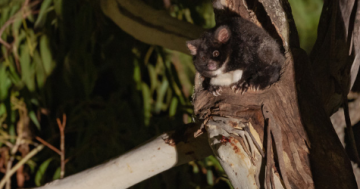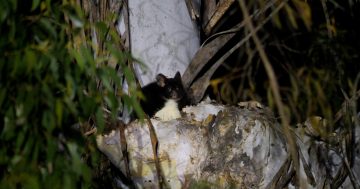
A greater glider spotted in Tallaganda State Forest. Photo: World Wide Fund for Nature-Australia.
Environmental groups have accused the NSW Environment Protection Authority (EPA) of backflipping over protections for endangered greater gliders.
Trees used by gliders are protected from logging by exclusion zones, which are identified by the observation of a glider entering or leaving a hollow.
The groups said gliders usually left their hollows in the first hour after sunset and the only way a search could be effective was if it was conducted during that window of time.
They said while the EPA had introduced a rule for searches to begin in the first hour after sunset, on Monday (27 May), the authority “backflipped” as it said only the first surveys of the night were to start within 30 minutes of sunset.
The EPA now requires Forestry Corporation of NSW (FCNSW) to implement a 25-metre logging exclusion zone around any tree in which a glider is seen during a search. This is in addition to exclusion zones that protect glider den trees.
“These amendments have been made to increase protections for other trees known to be used by greater gliders, where dens have not necessarily been identified but are likely to be present,” an EPA spokesperson said on Monday.
However, the environmental groups claim that a 25-metre exclusion zone is not effective protection and the wording of this new rule appears to exclude acceptance of greater glider sightings by community members.
“Without these amendments and clarity to search and survey requirements, FCNSW has advised the current conditions would have a material impact on the state’s wood supply,” the EPA spokesperson said.
They also said the EPA would not issue stop work orders at this time.
“However, we are still investigating potential non-compliances with the SSBCs [site-specific biodiversity conditions],” they said.
World Wide Fund for Nature-Australia conservation scientist Dr Kita Ashman said there was no ambiguity about the previous protocols, which clearly stated all surveys needed to start at a time that would allow for identifying den trees.
“Now what we have is the removal of that requirement, which means only the first survey will be of any use for identifying dens,” she said.
Dr Ashman said the research was clear that gliders had an average home range of about two to three hectares, so if the purpose of the new 25-metre buffers was to protect gliders and their habitat, then it fell “incredibly short”.
“It provides 0.2 hectares of protection for a species that needs two to three hectares,” she said.
“The buffers around gliders could have been a significant step forward if they were informed by science which suggests they need to be closer to 100 m.”
Wilderness Australia operations manager Andrew Wong said this outcome was “a roadmap to extinction for the greater glider”.

Dr Kita Ashman releases a GPS-collared greater glider in the Tallaganda State Forest. Photo: World Wide Fund for Nature-Australia.
“The EPA must clarify that community records for greater glider sightings will be accepted along with records from Forestry Corporation, and that those community records will result in the same logging exclusion zones being applied,” he said.
Nature Conservation Council NSW CEO Jacqui Mumford said if the EPA continued to prioritise the timber industry over protecting threatened and endangered species, then the greater glider’s fate was sealed.
“The EPA needs to stop capitulating to Forestry Corporation NSW and do what’s needed to protect species like the greater glider that have been pushed to the brink of extinction,” she said.
A spokesperson for Forestry Corporation of NSW said the EPA’s statement did confirm that its recent nocturnal surveys were conducted in line with the shared understanding of the EPA and Forestry Corporation regarding the timing of these surveys.
“Any time regulatory changes are made we need to understand the impact on operational requirements,” the spokesperson said.
“Forestry Corporation has had to stand down 15 operations while we review these changes and determine what will need to be done under the new ruleset to ensure compliance.
“These operations were supplying wood to many businesses on the north and south coast who produce essential timber products that our communities rely upon for housing, construction and infrastructure.”
Meanwhile, in May, the NSW Court of Appeal found environmental groups definitively have the right to challenge Forestry’s alleged breaches of the law, following a South East organisation’s “historic” courtroom win as part of its attempt to protect three species of glider.
Also, several environmental groups alleged the corporation had breached a rule designed to protect endangered greater gliders 188 times in state forests.















